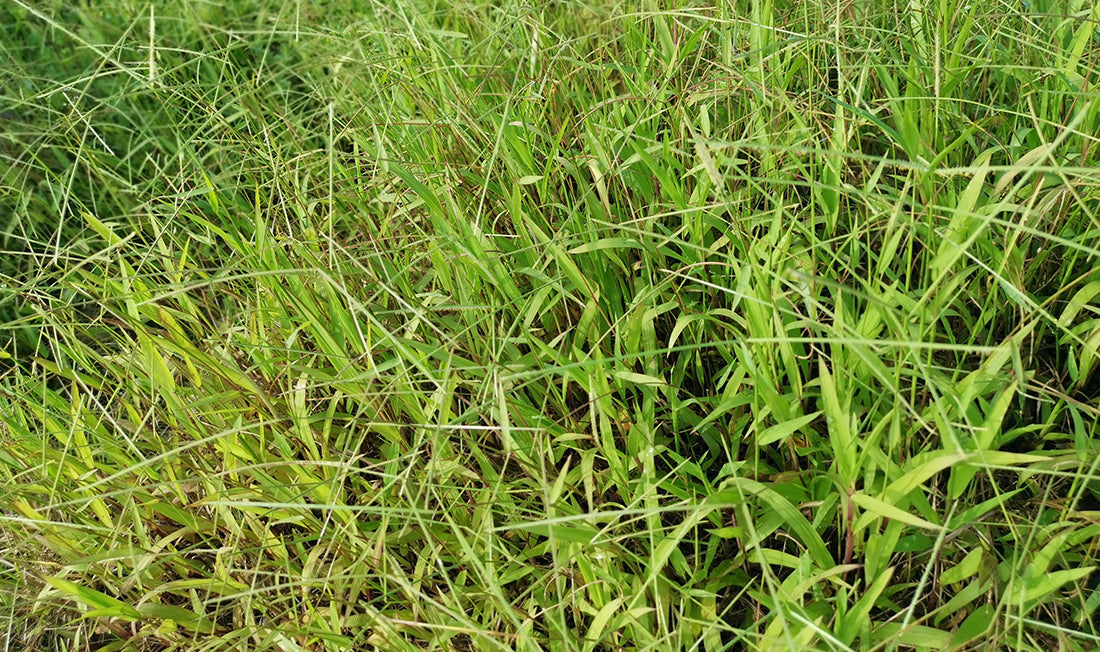Bahiagrass is a warm-season, low-maintenance turfgrass used primarily throughout the southeastern United States. It is known for its tolerance to heat and drought but not necessarily for its beauty. It was originally brought to the U.S. as a pasture grass adapted to the sandy soils common along the gulf coast, so it’s not going to make for the most aesthetically pleasing lawn. However its low maintenance needs may make it the grass for you if you don’t have the hours of time to pour into maintaining your lawn.
Bahiagrass is an aggressive grower that is capable of choking out weeds and other grasses. It is moderately shade tolerant, but like most warm-season grasses, it will appreciate as much sun as you can provide. Bahiagrass spreads through short rhizomes and stolons and produces a very deep root system. This makes it rather drought tolerant, but during times with little rainfall, will look its best with some supplemental irrigation.
Mowing Heights for Bahiagrass

Selecting a taller height of cut for your bahiagrass lawn will help it with growing a deep, extensive root system. This allows the grass to be more tolerant of stress, especially from drought. Bahiagrass is known for its unsightly seed head production and will need to be mowed in order to remove those. Other than that, it grows rather slowly and may not need to be mowed more than once every 7 days. As with any grass, take care not to remove more than 1/3rd of the total length of the grass blades at anyone mowing.
Fertilizing Bahia
Bahiagrass requires less fertilizer than many other warm-season grasses. Avoid fertilizing if your bahiagrass is dormant due to drought or cold temperatures. The longer your growing season, the more fertilizer you will need to apply to keep your lawn well fed. Bahiagrass can typically get by with as little as 1 and as much as 3 lbs of nitrogen per 1000 sq. ft. of lawn per season. Make sure to apply a nitrogen source that includes slow-release nitrogen like SLS 28-0-0 with 30% slow-release N. Make sure to never apply more than .75 lbs of nitrogen per 1000 square feet at any one fertilizer application date.

If your bahiagrass appears yellow and chlorotic, it may be suffering from iron deficiency if your soil pH is above 7. Liquid foliar iron products like SLS Darker Green and SLS Lawn Energizer are effective at supplying supplemental nitrogen to remedy the yellowing of your turf.
How Much Water Does Bahiagrass Need?
Bahiagrass is known for its ability to survive extended periods of drought. Best irrigation practice is to only irrigate when the grass is displaying signs of drought stress. This typically appears as a blueish gray color of the turf or if footprints remain visible on the grass for longer than usual. If this is the case, it’s time to irrigate.

Bahiagrass is able to survive extended periods of drought by entering a state of drought-induced dormancy. This means the grass will turn brown and wait it out until conditions become more favorable for growth. If you have the ability to irrigate your bahiagrass lawn, you can prevent it from entering a state of dormancy with irrigation. If you don’t have the ability to irrigate and your lawn has turned brown due to drought, stay off the lawn until the next round of rainfall helps the lawn green back up and begin growing again. This means no mowing or fertilizing the lawn until it has left its period of drought-induced dormancy.
Common Pests Affecting Behia
Bahiagrass does not have many natural pests that will affect its growth.

Mole crickets can be a problem as they burrough through the soil and uproot the lawn, causing desiccation. Contact your local extension office for more information about what insecticides are best to use to control mole cricket damage. Weeds are best controlled with a preemergence herbicide in the fall and spring. Breakthrough weeds can be controlled with a postemergence herbicide. Make sure not to use herbicides that contain metsulfuron or atrazine as these can cause damage to bahiagrass lawns. Nematodes and disease are rarely a problem with bahiagrass lawns but could be the culprit of poor growth, if other causes have been ruled out.
By following these tips, you can ensure a healthy and beautiful (as beautiful as bahiagrass can look) lawn that will last for years to come. Remember to always follow the instructions on any fertilizers or pesticides and to wear protective clothing when applying them. WIth proper care, bahiagrass will provide a great low-input surface for your home or business.









